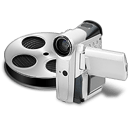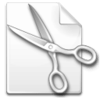The steps
- Here are the steps of editing a dramatic conversation (dialog). Remember: These rules apply only to a conversation in a dramatic scene.
Step 1 - Select the best audio
- For each sentence, you must select the best shot based on the quality of the spoken words.
- Don't worry about the picture
- With professionally filmed dailies, the picture is usually good, even for the worst of the circle takes (which are the best of the film dailies.) You should have an acceptable picture no matter which audio snippet you select.
- Compare only one sentence at a time
- Normally, each piece of the script is assembled into a conversation, one piece at a time. Conversations in motion pictures tend to have very short dialog... one sentence each, back and forth, back and forth. Therefore, look at only one sentence at a time. Find all of the takes that have the sentence and listen to how the actor say just those words.
- Start by rejecting the bad sounding dialog for that sentence. Then it becomes easy to find the best clip for that sentence.
- Adjust the natural rhythm
- Once you have selected the best audio, you adjust the edits of the audio to create a natural rhythm of the conversation -- back and forth, back and forth. Therefore, you must adjust the gaps between the pieces of dialog.
- Fortunately, when you have highly skilled actors, their natural speaking voice will already have perfect timing between each piece of dialog (between each sentence.) Just cut half way between sentences and it will probably already be perfect.
- Again, don't worry too much about the picture for now
- When you are finished selecting the best audio, the picture might not look ideal but the audio will sound OK. The scene will sound like a real conversation even though the different pieces of the conversation come from many different takes. That is absolutely amazing!
- Microphone limitations
- For most filmmaking, there was only one microphone so most of the audio is unuseable. You can use only the shots where the microphone is pointing directly at the actor who is talking. This makes selecting the audio very easy for a scene.
Step 2 - Next adjust the picture (but not the audio)
- Once the audio is perfect, lock the audio. From now on, the audio never changes.
- Once the audio is locked, you adjust the picture by rolling the picture edits forward and backward to find the best visual transistion. This is done by trial and error. This is called an "L-Cut".
Step 3 - Add cut away shots
- Once the audio and the picture edits are perfect, you can add cut-away shots (or insert shots) to enhance the visual look of the scene.
Step 4 - Add the musical score
- Since most of the mood of a scene is created with music, you need to add background music and narrative film music (music which tells a story.)
- As you add narrative film music, you might want to add additional room for the music between the sentences of the dialog. In that case, you go back to step 1 and start all over again to add the extra gaps between the sentences of the dialog. Then things get really fun!
Step 5 - Add sound effects
- Only the dialog is recorded on the movie set. Almost all other sounds must be in post production. You have to add sound effects, walla, ambience and other sounds to make the scene seem real.
|
L-Cuts
- Creating L-Cuts
- An "L-Cut" is where the audio and the picture are not edited at the same point. This edit looks like an "L". Hence the name "L-Cut". Wow!
- Rolling the picture edits
- Everytime you edit for sound, lock the sound track, and then roll the picture edits to find the best visual transition, you create "L-Cuts". If you use this method of editing a conversation, you cannot avoid creating "L-Cuts".
- You can create "L-Cuts" other ways but my method is, by far, the easiest way to do it. This procedure is the easiest to understand.
- Accentuate and emphasize
- L-Cuts do more than just create a nice transition point for the picture. L-Cuts can also emphasize one actor over another by showing the listener's anticipation or reaction to the conversation.
- This is very subtle so you need to study this carefully. This is explained in great detail in Lesson #3 and there are two DVD-Video disks specially designed to show how to make L-Cuts and their impact on storytelling.
|










